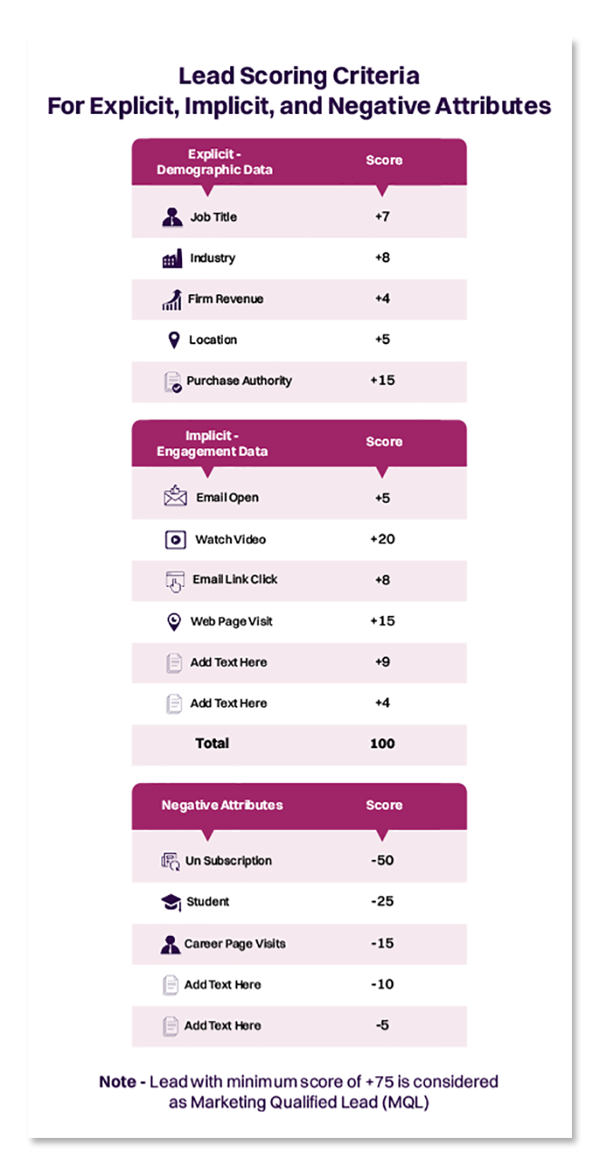
6 Lead Scoring System Best Practices to Boost Your Sales
Are you tired of generating countless leads that don't convert into sales? Well, we have a solution that could save you time and increase your revenue.
Introducing the power of lead scoring models! But wait, before you jump into it, it's crucial to tailor the model to your business needs.
By assigning scores to each lead, you can identify the most promising prospects and allocate your sales team's efforts accordingly. This means no more wasting
resources on dead-end leads!
So if you're a B2B company founder or sales and marketing professional, keep reading to learn about the six best practices for implementing an effective lead scoring model that will skyrocket your sales.
So, let us learn more about the lead scoring system.
6 Sales Lead Scoring System Best Practices for Your Sales Funnel
It is important to follow best practices while creating a sales lead scoring model for effective results. Below we have mentioned 6 most valued best sales funnel best practices. Check them out:
1. Defining Lead Scoring Criteria
Lead scoring criteria help you determine potential customers or the worthiness of leads.
It involves attaching specific values to leads based on their behavior relevant to your business. Here’s how to define your business’s lead scoring criteria:
1. Identifying The Characteristics Of A Qualified LeadFollow these 3 simple steps:
- Use a combination of explicit, implicit, and negative criteria to identify and categorize your leads.
- Once done, prioritize them based on their likelihood of converting into customers. To do this, assign lead scores based on their demographic and behavioral data.
- Further, use these scores to create a lead scoring framework.
Check out this sample on how to assign lead scores:

- Explicit Criteria: These are the specific, measurable attributes of a lead. They include demographics determining leads' interest and fit for your product/service. Explicit criteria include job title, company size, industry, budget, and geographic location.
- Implicit Criteria: These are behavioral signals that a lead may exhibit.
For example, a lead may visit certain website pages, download resource content, or attend a webinar. Tracking these behaviors can help you measure their level of engagement and interest.
You can combine implicit and explicit criteria to get a complete picture of a lead's potential value. - Negative Criteria: These attributes or behaviors can negatively impact a lead's score. They indicate a lower level of fit or interest.
For example, when a lead opts out of email communications or shows significant disinterest in previous interactions.
You need to exclude these leads from your priority list.
2. Setting A Lead Scoring Framework:
Once leads fulfill the defined lead scoring criteria, you can distribute weightage to them via a lead scoring framework. Here’s an example of how you can set up a framework:
| Action Taken | Score | Demographic | Score |
| Submits Form | 7 | VP of Sales | 10 |
| Opens Email | 7 | CMO | 8 |
| Visits Pricing Page/Plan Page | 9 | CEO | 8 |
| Visits Any Page | 6 | Sales Lead | 10 |
| Clicks Email Links | 8 | Marketing Associate | -10 |
| Books A Meeting | 10 | Senior Manager | 8 |
| Creates A Contact | 7 | Consultant | 2 |
| Replies To An Email | 8 | Director | 7 |
3. Establishing A Scoring Threshold
Now, let's determine which of your leads are "hot" and ready for sales follow-up. Here's how you establish a scoring threshold:
- Determine your business goals: Before setting a threshold, you must understand what you hope to achieve with your sales lead scoring system. It will help you decide a certain "hot" lead score level.
- Analyze past sales data: Set a starting point for your threshold. Then, determine what score has correlated with successful conversions in the past.
- Set an initial threshold: Set an initial threshold based on past sales data and lead behavior.
For example, you can set a lead as "hot" if they score above 70. Similarly, you can define different lead thresholds based on their scores, like mild (between 40-70) or cold (below 40). - Test and refine the threshold: Regularly review and adjust the threshold based on your results. A low threshold shows you spend more time and resources following up on unqualified leads.
However, a very high threshold suggests missed opportunities to engage with potential customers.
2. Scoring Leads In Real-Time
Scoring leads in real-time refers to the process of evaluating and ranking potential customers based on their likelihood to convert into paying customers in real-time.
Here’s how you can make it happen:
1. Automatically Scoring Leads As They Enter The System
Use marketing automation or lead management software to automate the scoring process, such as HubSpot, Marketo, Keap and others. Here are the elements you need to focus on while automating lead scoring:
- Define scoring criteria: Determine the specific criteria and characteristics to score leads as they enter the system. Use explicit, implicit, and negative criteria for effective scoring.
- Weight the criteria: Determine the relative importance of leads by weighting each criterion.
For example, if your prime targets are local businesses, give a lead a higher score based on their location than their budget or company size. - Set up scoring rules: The rules must revolve around the assigned point values to each criterion based on its importance level.
First, determine the maximum possible score and create a rubric that reflects the criteria and point values.
Then, apply the rubric to each lead to calculate its score. Ensure to direct appropriate resources toward those with the highest scores.
2. Updating And Alerting The Sales Team To New High-Scoring Leads
Keeping your sales team updated and altered about new changes is a key lead scoring best practice. Here's what you have to do:
- Set up alerts in your lead management or marketing automation system. It should notify sales reps when a new high-scoring lead is generated. The alerts should include the lead's contact information, score, and other relevant details.
- Determine what score will trigger an alert for the sales team to get active around a particular lead. Typically, it will be the score you use as your threshold for a "hot" lead.
- Decide how the sales team will get notifications of new high-scoring leads’ entries. Options include email, SMS, push notifications or a message within the sales CRM.
3. Creating A Lead Follow-Up Plan
Once you sort your leads based on their score, it's time to nurture them. Let's learn how it's done:
1. Create Lead Nurturing Campaigns:
Based on the lead score, design B2B lead nurturing campaigns such as:
- Automated emails: Use predetermined lead scoring triggers or schedules to automate targeted email delivery. They generate 320% higher revenue compared to non-automated emails.
- Phone calls: Host a series of phone calls to a targeted audience after initial contact. Aim to build healthy customer relationships and increase conversions. As per data, 80% of sales approaches need five follow-up calls on average to close a deal.
- LinkedIn InMail: Send personalized messages to a targeted audience on LinkedIn; it nurtures your professional relationships and generates more high-value leads. The InMail tool by LinkedIn has a 300% more response rate than emails.
- Targeted multi-channel marketing: Combine multiple communication channels to reach customers. These channels may include email, direct mail, and social media. Data says 72% of prospects prefer connecting with businesses through multi-channels.
- Cold outreach on social media: Reach out to potential customers or clients via DMs on social media platforms. You don’t need any prior relationship or contact with them.
79% of sales reps using social media to outreach leads outperform those who don't.
2. Determine Follow-Up Actions:
Decide on the appropriate follow-up actions without turning them off for each lead score.
For example, you can decide on phone calls as ideal follow-up action for high-scoring leads. Further, for low-scoring leads, you can decide on an automated email system for follow-up.
- Assign lead ownership: Assign sales team members as owners to handle particular leads. It lets them filter all the leads they own and quickly respond when such leads start a conversation. It also will ensure leads are followed up promptly.
- Document the process: Document the lead follow-up plan, including the lead scoring criteria, lead nurturing campaigns, and follow-up actions. It will ensure everyone on the team follows the same process, and you can update and improve the plan over time as needed.
4. Making Use Of Social Influence
Connect with a famous marketer or well-known professional in your niche industry. Offer them to use your product/service. There is a high chance they’ll share their experience with their followers if they find your offering beneficial.
Thus, you can get your product endorsements free of cost. Moreover, influencers can offer detailed reviews of your product to your target audience.
The benefit you'll receive from their social influence would be enormous. Your product will get in front of large audiences through influencers. Many of them might be your targeted prospects.
5. Instilling Urgency
First, list out all “Hot” leads from your sales lead scoring system. It indicates leads who highly engage with your website and are at the last stage of your sales funnel.
Next, take advantage of your leads' readiness to buy your product. Then, add urgency to your product's sale emails by announcing limited offers or subscription packages.
An Experian's report states a sales boost of 16% after implementing urgency in email subject lines.
6. Measuring And Improving Lead Scoring Results
You can track the following key metrics to determine the effectiveness of your lead scoring system:
- Sales Cycle Time: This metric measures the time it takes for a lead to move from initial contact to becoming a customer. A shorter sales cycle is generally a good indicator that your lead scoring system is effective.
- Lead Quality Score: This metric measures your leads' quality based on your information about them. A high lead quality score indicates the increased effectiveness of your lead scoring system.
- Lead Engagement: This metric measures how engaged leads are with your sales and marketing materials. Ensure it remains high.
Conclusion
Following the lead scoring system best practices can help you prioritize your sales efforts and focus on the most promising leads. By assigning scores to leads based on various criteria, you gain valuable insights into the interests and needs of your target audience. In addition, a lead scoring system improves collaboration between your sales and marketing teams.
Thus, each involved team can aim towards achieving the same goal. We recommend partnering with a reliable B2B marketing service provider to make the entire lead scoring process seamless.
At Revnew, our experts optimize your marketing efforts with the best-in-market tools like HubSpot and Salesforce. We assure you reach your target groups efficiently and quickly.




